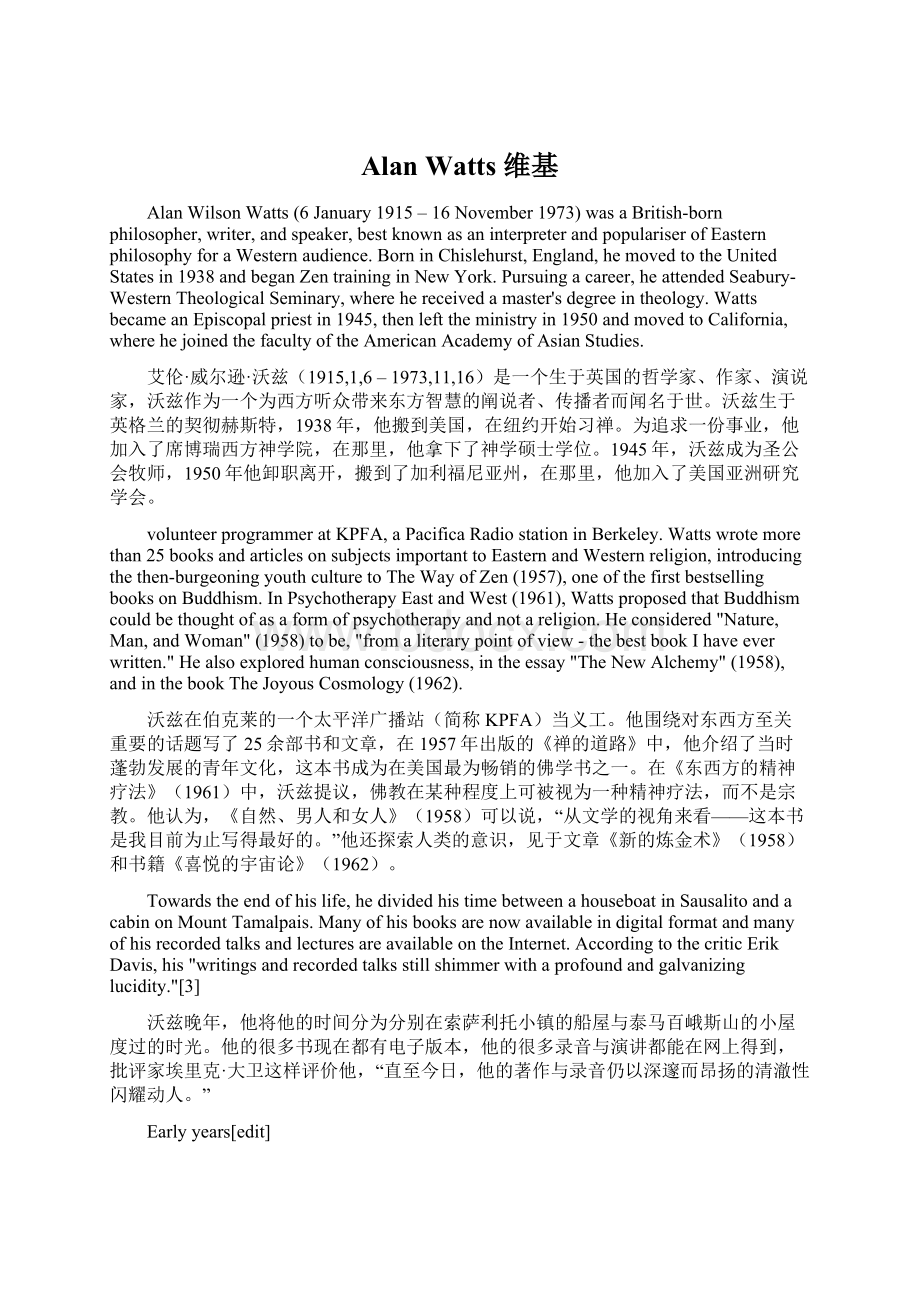Alan Watts 维基.docx
《Alan Watts 维基.docx》由会员分享,可在线阅读,更多相关《Alan Watts 维基.docx(13页珍藏版)》请在冰豆网上搜索。

AlanWatts维基
AlanWilsonWatts(6January1915–16November1973)wasaBritish-bornphilosopher,writer,andspeaker,bestknownasaninterpreterandpopulariserofEasternphilosophyforaWesternaudience.BorninChislehurst,England,hemovedtotheUnitedStatesin1938andbeganZentraininginNewYork.Pursuingacareer,heattendedSeabury-WesternTheologicalSeminary,wherehereceivedamaster'sdegreeintheology.WattsbecameanEpiscopalpriestin1945,thenlefttheministryin1950andmovedtoCalifornia,wherehejoinedthefacultyoftheAmericanAcademyofAsianStudies.
艾伦·威尔逊·沃兹(1915,1,6–1973,11,16)是一个生于英国的哲学家、作家、演说家,沃兹作为一个为西方听众带来东方智慧的阐说者、传播者而闻名于世。
沃兹生于英格兰的契彻赫斯特,1938年,他搬到美国,在纽约开始习禅。
为追求一份事业,他加入了席博瑞西方神学院,在那里,他拿下了神学硕士学位。
1945年,沃兹成为圣公会牧师,1950年他卸职离开,搬到了加利福尼亚州,在那里,他加入了美国亚洲研究学会。
volunteerprogrammeratKPFA,aPacificaRadiostationinBerkeley.Wattswrotemorethan25booksandarticlesonsubjectsimportanttoEasternandWesternreligion,introducingthethen-burgeoningyouthculturetoTheWayofZen(1957),oneofthefirstbestsellingbooksonBuddhism.InPsychotherapyEastandWest(1961),WattsproposedthatBuddhismcouldbethoughtofasaformofpsychotherapyandnotareligion.Heconsidered"Nature,Man,andWoman"(1958)tobe,"fromaliterarypointofview-thebestbookIhaveeverwritten."Healsoexploredhumanconsciousness,intheessay"TheNewAlchemy"(1958),andinthebookTheJoyousCosmology(1962).
沃兹在伯克莱的一个太平洋广播站(简称KPFA)当义工。
他围绕对东西方至关重要的话题写了25余部书和文章,在1957年出版的《禅的道路》中,他介绍了当时蓬勃发展的青年文化,这本书成为在美国最为畅销的佛学书之一。
在《东西方的精神疗法》(1961)中,沃兹提议,佛教在某种程度上可被视为一种精神疗法,而不是宗教。
他认为,《自然、男人和女人》(1958)可以说,“从文学的视角来看——这本书是我目前为止写得最好的。
”他还探索人类的意识,见于文章《新的炼金术》(1958)和书籍《喜悦的宇宙论》(1962)。
Towardstheendofhislife,hedividedhistimebetweenahouseboatinSausalitoandacabinonMountTamalpais.ManyofhisbooksarenowavailableindigitalformatandmanyofhisrecordedtalksandlecturesareavailableontheInternet.AccordingtothecriticErikDavis,his"writingsandrecordedtalksstillshimmerwithaprofoundandgalvanizinglucidity."[3]
沃兹晚年,他将他的时间分为分别在索萨利托小镇的船屋与泰马百峨斯山的小屋度过的时光。
他的很多书现在都有电子版本,他的很多录音与演讲都能在网上得到,批评家埃里克·大卫这样评价他,“直至今日,他的著作与录音仍以深邃而昂扬的清澈性闪耀动人。
”
Earlyyears[edit]
WattswasborntomiddleclassparentsinthevillageofChislehurst,Kent(nowsouth-eastLondon),in1915,livingat3(now5)HolbrookLane.HisfatherwasarepresentativefortheLondonofficeoftheMichelinTyreCompany,hismotherahousewifewhosefatherhadbeenamissionary.Withmodestfinancialmeans,theychosetoliveinpastoralsurroundingsandAlan,anonlychild,grewupplayingatbrookside,learningthenamesofwildflowersandbutterflies.[4]Probablybecauseoftheinfluenceofhismother'sreligiousfamily[5]theBuchans,aninterestin"ultimatethings"seepedin.ButitmixedwithAlan'sowninterestsinstorybookfablesandromantictalesofthemysteriousFarEast.[6]
早期岁月
沃兹1915年生于肯特郡(现位于伦敦东南部)契彻赫斯特的一个村庄里,父母是中产阶级,住所位于霍尔布鲁克路3号(现在是5号)。
他的父亲是米其林轮胎公司伦敦办事处的代表,他的母亲是一个家庭主妇,祖父曾当过传教士。
因家庭条件一般,他们选择居住在乡村周边,还是孩子的沃兹在水边嬉戏、学习野花和蝴蝶的名字而成长。
也许是因了他母亲Buchans?
的宗教家庭的影响,对“终极真理”的兴趣潜移默化地渗入了他的脑海。
但其中还掺杂了艾伦了解到的关于神秘的远东的寓言故事书和浪漫故事。
Wattsalsolaterwroteofamysticaldreamheexperiencedwhileillwithafeverasachild.[7]DuringthistimehewasinfluencedbyFarEasternlandscapepaintingsandembroideriesthathadbeengiventohismotherbymissionariesreturningfromChina.ThefewChinesepaintingsWattswasabletoseeinEnglandrivetedhim,andhewrote"Iwasaestheticallyfascinatedwithacertainclarity,transparency,andspaciousnessinChineseandJapaneseart.Itseemedtofloat...".[8]Theseworksofartemphasizedtheparticipativerelationshipofmaninnature,athemethatstoodfastthroughouthislife,andonethatheoftenwritesabout.See,forinstance,thelastchapterinTheWayofZen.[9]
后来,沃兹还写了一个他童年时在发烧中做的神秘的梦。
在这段时期,他受到来自中国的传教士送给母亲的远东的风景画和刺绣的影响。
沃兹在英格兰看到的有限的几件中国画吸引了他,他写道,“在美学意义上,我为中国和日本画中的明澈、透明、空间感深深迷醉。
它好像能浮起来……”这些艺术作品强调人应参与到与自然的关系中,这很快成了贯穿他一生的主题,他也经常在书中写到这一点。
例如,《禅的道路》的最后一章。
Buddhism[edit]
学佛生涯
SeatedGreatBuddha(Daibutsu),Kamakura,Japan
Byhisownassessment,Wattswasimaginative,headstrong,andtalkative.Hewassenttoboardingschools(whichincludedbothacademicandreligioustrainingoftheMuscularChristianitysort)fromearlyyears.Ofthisreligioustraining,heremarked"Throughoutmyschoolingmyreligiousindoctrinationwasgrimandmaudlin…"[10]
在日本镰仓大佛打坐
沃兹对自己的评价是,他想象力丰富,任性而健谈。
早年,他被送到寄宿学校(那里的教育涵盖了学术学习和强身派基督教的宗教训练)。
对这段宗教训练,他评价道,“在我整个的寄宿生活中,我的宗教学习是严格而令人感伤的。
WattsspentseveralholidaysinFranceinhisteenyears,accompaniedbyFrancisCroshaw,awealthyEpicureanwithstronginterestsinbothBuddhismandexoticlittle-knownaspectsofEuropeanculture.ItwasnotlongafterwardthatWattsfeltforcedtodecidebetweentheAnglicanChristianityhehadbeenexposedtoandtheBuddhismhehadreadaboutinvariouslibraries,includingCroshaw's.HechoseBuddhism,andsoughtmembershipintheLondonBuddhistLodge,whichhadbeenestablishedbyTheosophists,andwasnowrunbythebarristerChristmasHumphreys.Wattsbecametheorganization'ssecretaryat16(1931).TheyoungWattsexploredseveralstylesofmeditationduringtheseyears.
青年时代,沃兹在法国度过了几个假期,同行的还有弗朗西斯科·罗肖(FrancisCroshaw),一个富有的享乐主义者,他对佛教和欧洲文化所不熟知的异国情调有着强烈的兴趣。
不久之后,沃兹就感到有必要在他被教导的英国国教和他在许多图书馆(包括罗肖的)阅读到的佛教之间做一个选择。
他最终选择了佛教,并加入了“伦敦佛教小屋“(LondonBuddhistLodge),这个组织由神智学家建立,当时由律师克里马斯·韩弗瑞掌管。
16岁的沃兹(1931)成为组织的秘书,这几年,年轻的沃兹尝试了几种不同的冥想方式。
Education[edit]
教育历程
WattsattendedTheKing'sSchool,CanterburynextdoortoCanterburyCathedral.Thoughhewasfrequentlyatthetopofhisclassesscholasticallyandwasgivenresponsibilitiesatschool,hebotchedanopportunityforascholarshiptoOxfordbystylingacrucialexaminationessayinawaythatwasreadaspresumptuousandcapricious.[11]
沃兹在英国国教总教堂坎特伯里的国王学院学习。
尽管在学术上,他总是名列前茅,并且在学校担任要职,但他失去了一个牛津大学奖学金的机会,因为在一场关键的考试中,他的回答令人感觉冒昧唐突、反复无常。
Whenhelefthighschool,Wattsworkedinaprintinghouseandlaterabank.HespenthissparetimeinvolvedwiththeBuddhistLodgeandalsounderthetutelageofa"rascalguru"namedDimitrijeMitrinović.(MitrinovićwashimselfinfluencedbyPeterDemianovichOuspensky,G.I.Gurdjieff,andthevariedpsychoanalyticalschoolsofFreud,JungandAdler.)Wattsalsoreadwidelyinphilosophy,history,psychology,psychiatryandEasternwisdom.Byhisownreckoning,andalsobythatofhisbiographerMonicaFurlong,Wattswasprimarilyanautodidact.HisinvolvementwiththeBuddhistLodgeinLondonaffordedWattsaconsiderablenumberofopportunitiesforpersonalgrowth.ThroughHumphreys,hecontactedeminentspiritualauthors(e.g.theartist,scholar,andmysticNicholasRoerich,SarvapalliRadhakrishnan,andprominenttheosophistslikeAliceBailey).
他离开高中后,沃兹在一间印刷室工作,后来又去了银行。
他把业余时间都花在“佛教小屋”里,受到“混混古鲁”DimitrijeMitrinović的看顾(Mitrinović受到彼得(PeterDemianovichOuspensky),葛吉夫(G.I.Gurdjieff)以及诸如弗洛伊德、荣格、阿德勒等众多精神分析学派的影响。
)沃兹在哲学、历史、心理、精神疗法和东方智慧等领域广泛阅读。
他和他的传记作者莫妮卡·弗朗都认为,沃兹主要是一个自修者。
他在伦敦“佛教小屋”的修习对沃兹的个人成长提供了相当多的机会。
通过韩弗瑞,他与许多著名的灵修人士取得了联系,如:
艺术家、学者、神秘学家尼古拉斯(NicholasRoerich)和SarvapalliRadhakrishnan,以及杰出的神智学家爱丽丝(AliceBailey)。
In1936,aged21,heattendedtheWorldCongressofFaithsattheUniversityofLondon,heardD.T.Suzukireadapaper,andafterwardswasabletomeetthisesteemedscholarofZenBuddhism.[12]Beyondthesediscussionsandpersonalencounters,Wattsabsorbed,bystudyingtheavailablescholarlyliterature,thefundamentalconceptsandterminologyofthemainphilosophiesofIndiaandEastAsia.
在1936年,21岁的沃兹求学于伦敦大学的世界信仰大会,听说铃木大拙将会宣读论文,之后他见到了这位在佛教禅宗受人尊敬的学者。
除了这些探讨与个人交往外,沃兹通过学习可接触到的文学课程,吸收了许多印度及东亚的基本概念、术语及核心哲学思想。
Influencesandfirstpublication[edit]
影响及第一部著作
Watts'sfascinationwiththeZen(orCh'an)tradition—beginningduringthe1930s—developedbecausethattraditionembodiedthespiritual,interwovenwiththepractical,asexemplifiedinthesubtitleofhisSpiritofZen:
AWayofLife,Work,andArtintheFarEast."Work","life",and"art"werenotdemotedduetoaspiritualfocus.Inhiswriting,hereferredtoitas"thegreatCh'an(orZen)synthesisofTaoism,ConfucianismandBuddhismafter700CEinChina."[13]Wattspublishedhisfirstbook,TheSpiritofZen,in1936.Twodecadeslater,inTheWayofZen[14]hedisparagedTheSpiritofZenasa"popularisationofSuzuki'searlierworks,andbesidesbeingveryunscholarlyitisinmanyrespectsoutofdateandmisleading."
沃兹着迷于从20世纪30年代开始喜欢上的禅修,这种喜爱进一步发展,因为这一传统融合了灵性,交织着实修。
这一心路历程被写在《禅的精神:
关于远东的生活、工作、艺术之道》。
“工作”、“生活”和“艺术”并不因聚焦于灵性而贬损自身。
在他的作品中,他将之称为“伟大的禅,道、儒学与公元700年后佛法的同义词。
”1936年,沃兹出版了他的第一本书《禅的精神》。
20年后,他对《禅的精神》做出了负面评价,说这本书是“铃木早期作品的普及本,除了非常不符合学术规范,它又过时又误导人。
”
WattsmarriedEleanorEverett,whosemotherRuthFullerEverettwasinvolvedwithatraditionalZenBuddhistcircleinNewYork.RuthFullerlatermarriedtheZenmaster(or"roshi"),Sokei-anSasaki,whoservedasasortofmodelandmentortoWatts,thoughhechosenottoenterintoaformalZentrainingrelationshipwithSasaki.Duringtheseyears,accordingtohislaterwritings,Wattshadanothermysticalexperiencewhileonawalkwithhiswife.In1938WattsandhisbrideleftEnglandtoliveinAmerica.WattsbecameanAmericancitizenin1943.[15]
沃兹娶艾琳娜·艾弗瑞特为妻,她的母亲路德·弗勒·艾弗瑞特是纽约的一个传统禅学圈的成员。
路德·弗勒后来嫁给了禅学大师佐佐木指月(Sokei-anSasaki),尽管沃兹没有选择和佐佐木一起进入正规禅修中心,在某种程度上,他是沃兹的模范与导师。
在这些年里,根据他后来所著,沃兹在与他的妻子散步时有了又一神秘体验。
1938年,沃兹和他的新娘离开英格兰,去往美国,他于1943年成为美国公民。
Christianpriestandafter[edit]
基督牧师及之后
Thissectionneedsadditionalcitationsforverification.Pleasehelpimprovethisarticlebyaddingcitationstoreliablesources.Unsourcedmaterialmaybechallengedandremoved.(November2014)
这部分需要额外的引用以确证信息。
请根据可靠的资源加注引文帮助完善这篇文章。
原来来源不明的材料也许会受到挑战并被移除。
WattsleftformalZentraininginNewYorkbecausethemethodoftheteacherdidnotsuithim.HewasnotordainedasaZenmonk,buthef